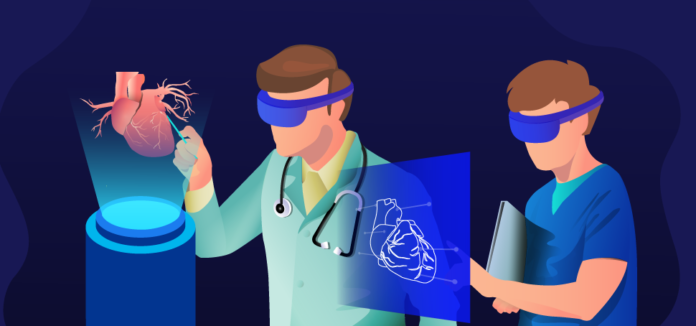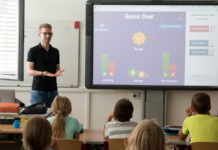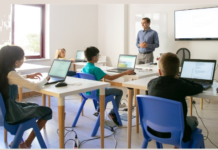Education is driving the future of VR more than any other industry outside of gaming. For many teachers, the idea of implementing virtual reality (VR) into the curriculum seems like a far-fetched notion. The technology seems too expensive, too primitive, or too impractical to fit into a typical class period.
But this is not actually true! Virtual reality in education is already taking over many classrooms. And there are many virtual reality products available today that are ready to deploy in the classroom!
In recent years, there have been rapid advancements in the technology. This has resulted in affordable and advanced hardware and software that show serious potential. There are even a number of free VR applications for teachers.
What are the practical applications of virtual reality in education? Where should you begin? In this guide, we look at 5 real examples for VR to explore.
Advantages of Using Virtual Reality in the Classroom
There are a lot of advantages in using virtual reality to teach in the classroom over traditional teaching methods:
- Solutions to problems can be visualized more clearly.
- Information can be shared visually and in a more appealing way.
- Students get to learn in an outside environment without actually leaving the classroom
These advantages make it easier for teachers as well because don’t have to develop their own virtual reality apps.
Not sure where to begin? Next we will look at specific examples of VR in the classroom. These are solutions that can be implemented with students and classrooms today.
Examples of Virtual Reality in Education
#1. Group Work
Group work is an absolute necessity in the classroom. it helps students exchange information, build a common understanding and explore new ideas with peers.
There are many virtual reality group work tools to assist in these efforts. The VRChat app is one app that makes educational group work easy in a virtual classroom.
Collaborate, meet, discuss, present, and make collective decisions while connected with others. Below are some examples of how a classroom can benefit from group work apps in VR:
- Allow students to experiment in a safer environment than handling chemicals in real life would otherwise allow.
- Learn about plants and their interaction with the environments through virtual growth cycles.
- Save on budget which would otherwise limit students’ ability to make these observations and analyses in the classroom.
- Improve understanding of abstract, spatial geometric concepts through manipulation of virtual 3D objects.
#2. Virtual Field Trips
Virtual field trips have become one of the most popular applications of VR technology for learning. Many schools have begun using The Discovery Education app to transport students to faraway and inaccessible parts of the planet.
Discovery Education is the global leader in standards-based digital content for students. Teachers can transforming their teaching by embracing this app for virtual reality in education.
With the app, students access learning resources and guided tours. Some of the hundreds of tours available in the app are:
- The frozen arctic
- NASA space center
- NFL Combine
- John Deere manufacturing plant
Discovery Education is free to download on IOS or Android. Teachers can invest in some of the low-cost cardboard headsets that can be attached to a smartphone. With these simple headsets, students can actively explore anything from Machu Picchu to outer space or the deep sea.
#3. Virtual Labs
The idea of ‘virtual labs’ is gaining traction as institutions try to expand their reach and cut costs. Virtual labs enhance student understanding and provide a different kind of hands-on training.
Virtual labs can be stripped-down in 2D with simple toggles and controls,, or 3D simulations that provide a more immersive experience. Some provide students with objective and step-by-step instructions, guiding them through the technical steps for carrying out complex procedures.
Others are completely open ended.
Labster, for example, lets students choose chemicals from a store-room shelf and use them however they want. With Labster’s virtual lab simulations, students work through real-life case stories, interact with lab equipment, perform experiments and learn with theory and quiz questions.
#4. Design and Art
Schools are also finding that virtual reality technology is a great way to spark students’ creativity and keep them engaged. Virtual reality is popular in architecture and design education.
Apps like Tilt Brush and Gravity Sketch are perfect for designing in virtual reality. Students can take computer-generated 3D models and place viewers in them to bring their plans to life.
These apps allow painting, sculpting, modeling and creating tangible objects in a virtual environment. They also allow students to create expressive works of art regardless of their experience.
That’s not all; they use touch controls to allow intuitive gestures and hand movements for a natural tactile experience.
#5. Exploring History
Just as VR can transport users across the world, it can also be used to simulate historical events from the past.
If a teacher is teaching World War 1, the want to give students an idea of what it was like to live during that time. TimeLooper is a free application that gives users an intimate look into the life of those who fought during WWI.
Timelooper has a real live location feature, which lets you view historical pictures and information about your surroundings. The app transports visitors to iconic moments in history through 360° virtual reality videos that align with real world locations and landmarks.
The stories featured in the app recreate historic moments and cultures through visual restorations of the buildings of the time.
As well, Timelooper users can view the surface of Mars , the International Space Station, Guggenheim, the Smithsonian, and the Louvre in full 360°.
Try VR In Your Classroom Today
These are some of the practical applications of virtual reality in education. If you are a teacher, principle, faculty member, or school board member, contact AR/VR Tips for ways to integrate this technology into your classroom. You can consult with them to buy the hardware, setup your curriculum, and bring virtual reality into your school.








